Bust of Septimius Severus wearing a cuirass
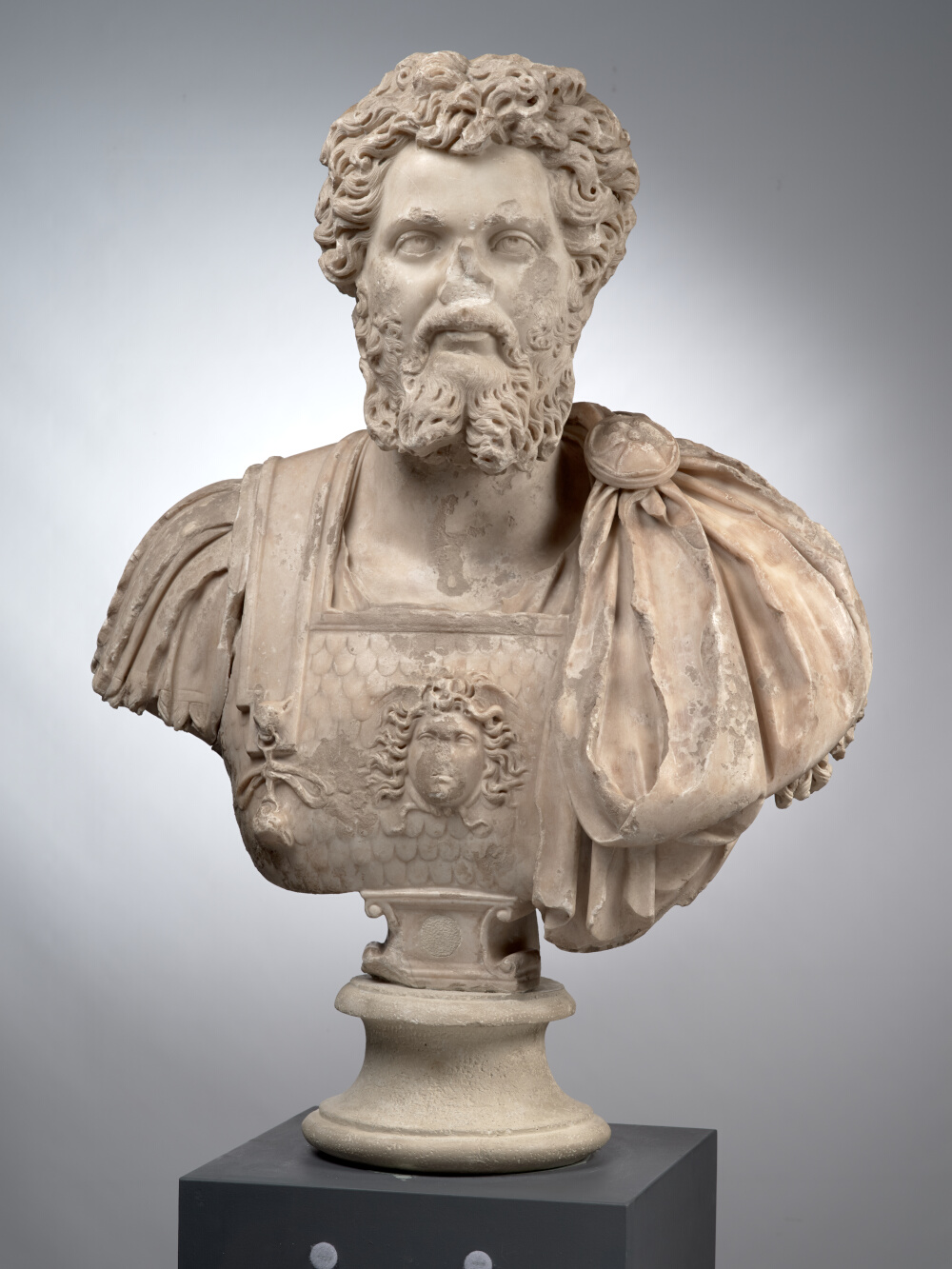
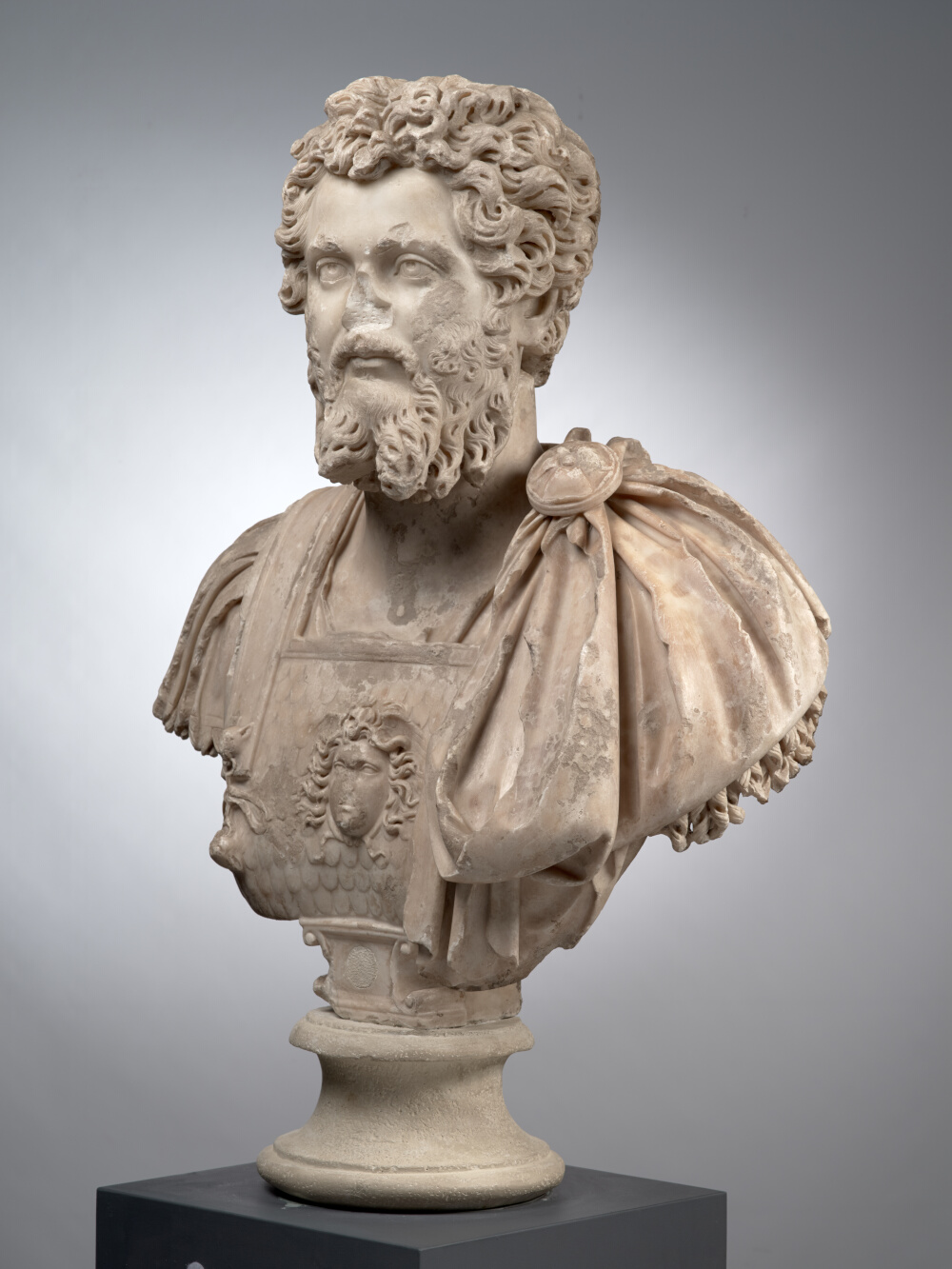
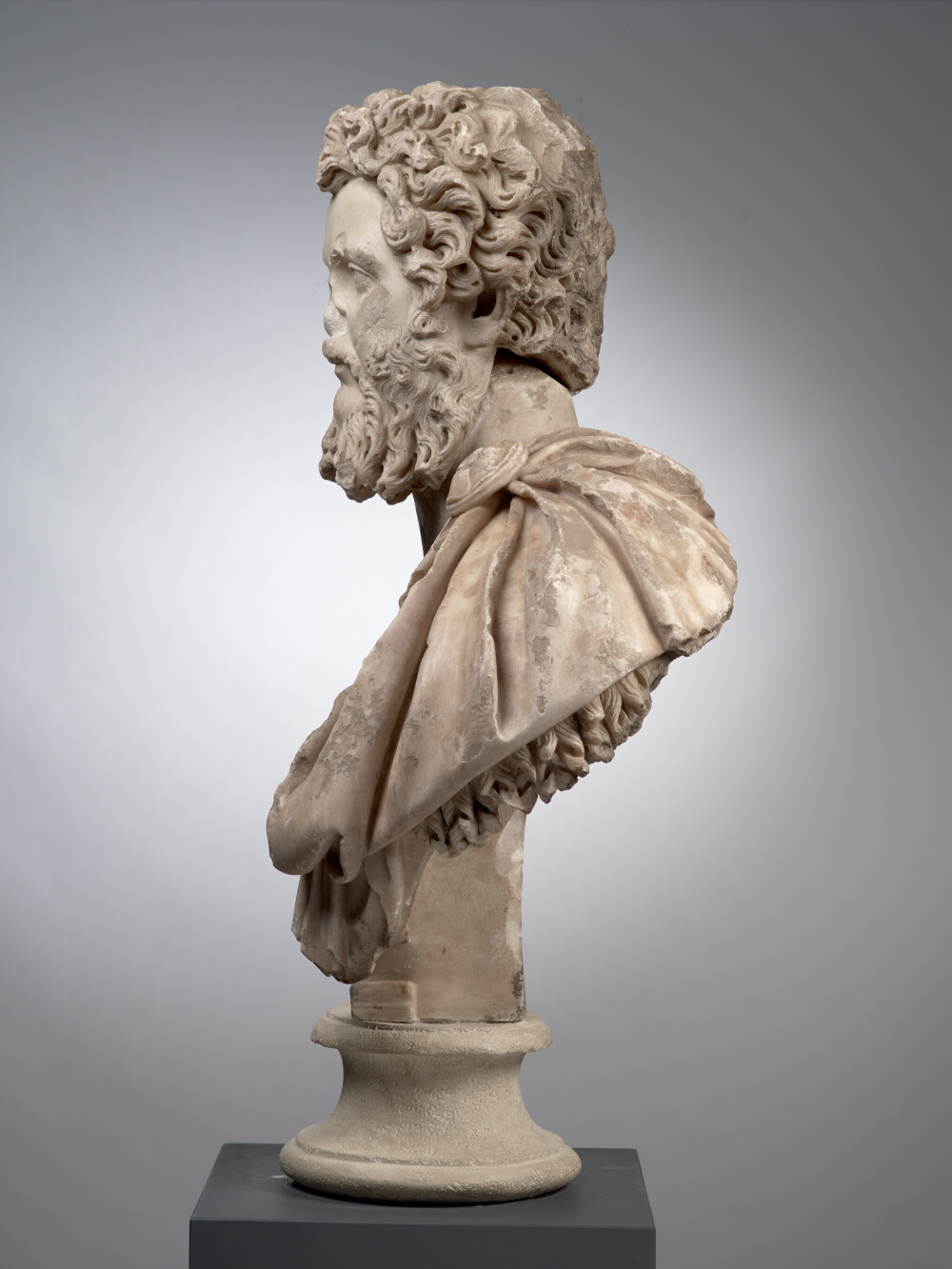
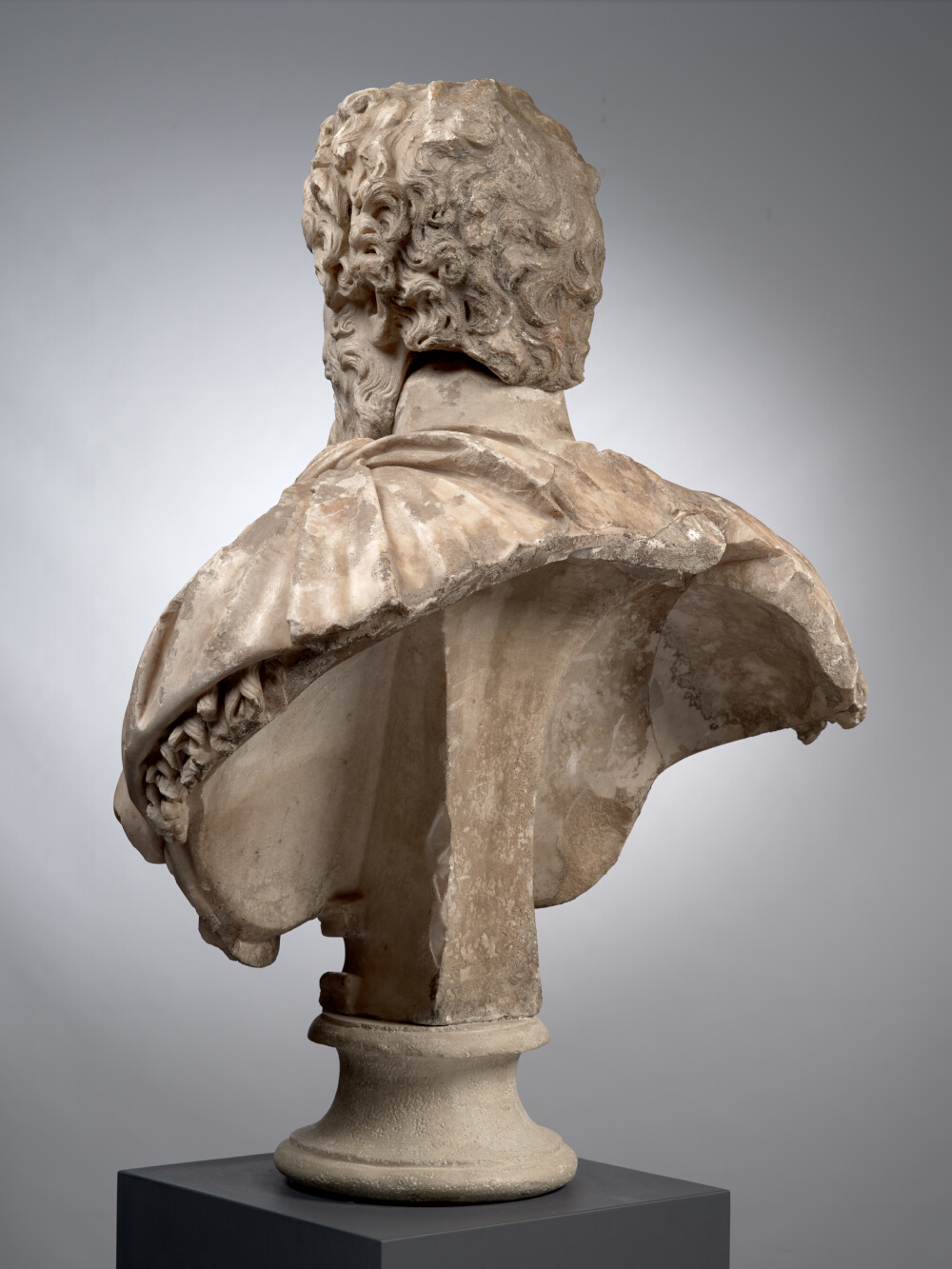
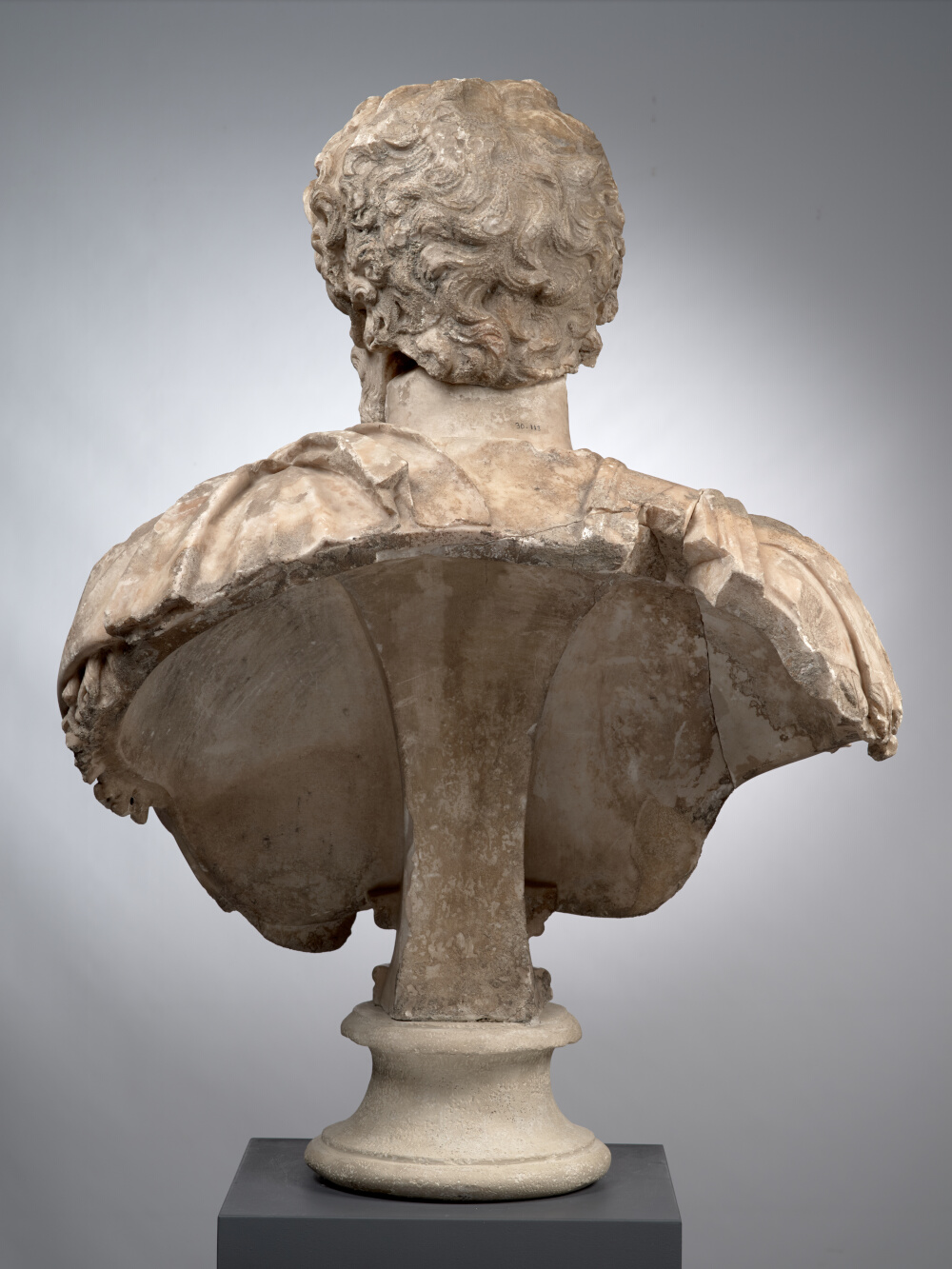
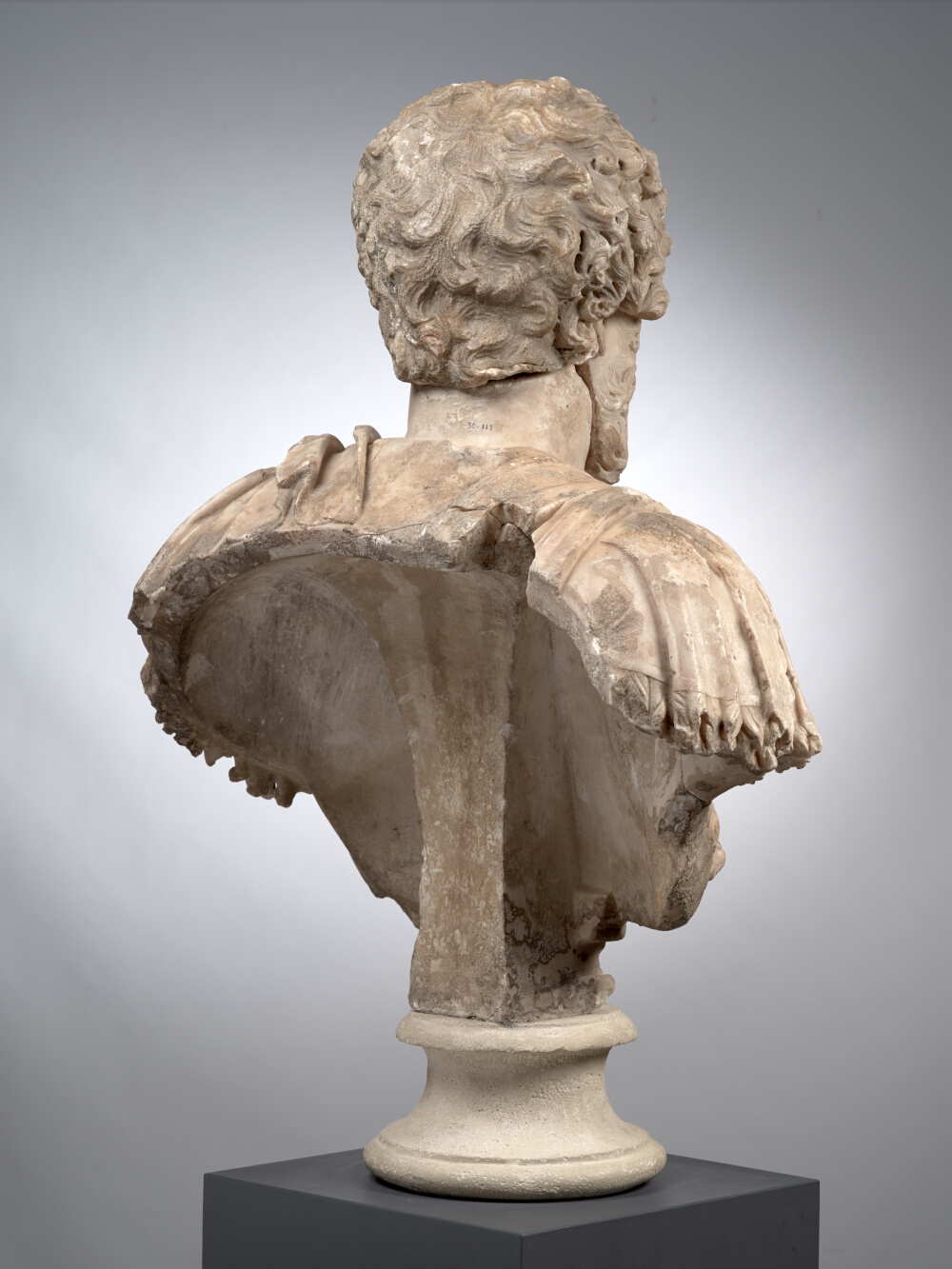
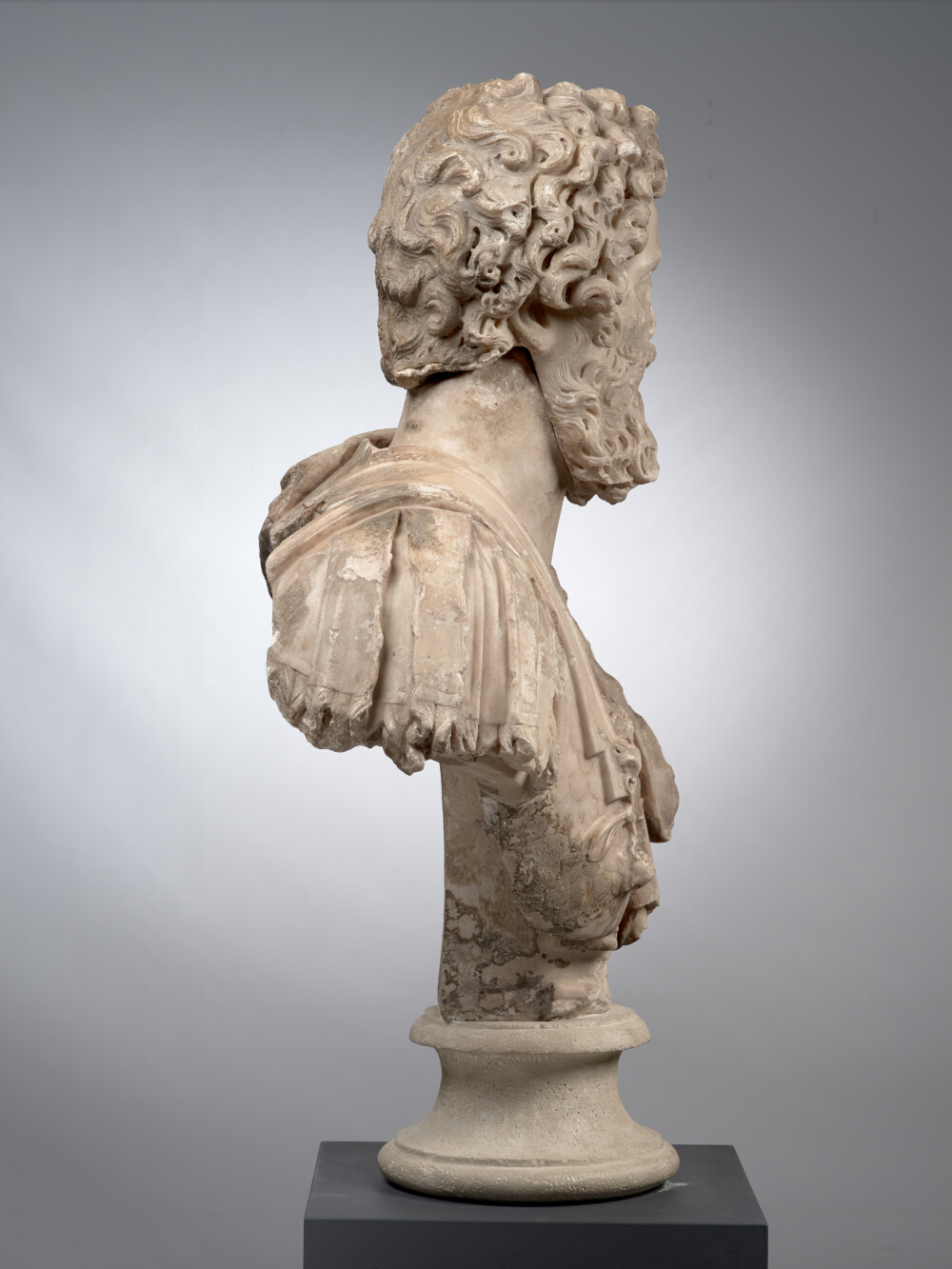
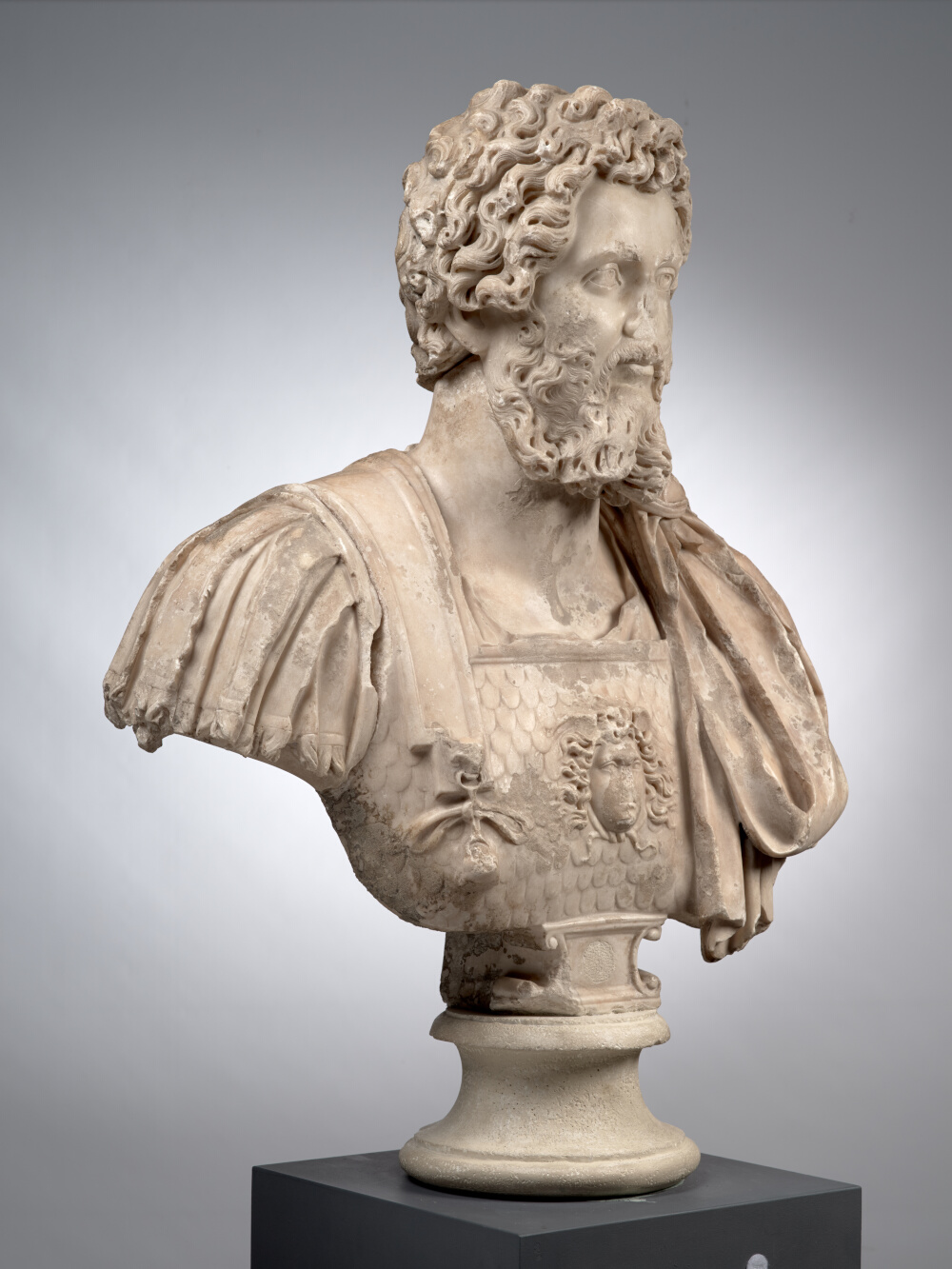
- Biographic data
- 145 - 211
Emperor from 193 to 211 - Date de création
- Between 195 and 203
- Type
- of the "adoption" type
- Material
- Göktepe marble, district 3 (Turkey)
- Dimensions
- H. 73,5 x l. 66 x P. 36 (cm)
- Inventory number
- Ra 66 a
- Photo credits
- Daniel Martin
As with Trajan, no less than four portraits of Septimius Severus were discovered in Chiragan, which is quite exceptional. The Roman workshop that created this head may also be the author of two others of the same type, kept in Copenhagen (Ny Carlsberg Glyptotek) and Rome (Palazzo Massimo alle Terme). Compared to another « accession » type head found in Chiragan, this sculpture portrait tends to idealise the features, and sports a higher hairline on either side of the fringe.
This representation belongs to the so-called « adoption » type, because of the very great similarity between its face and those of portraits of Antoninus Pius and Marcus Aurelius. This is an example of the assimilation (« Angleichung ») that some emperors adopted for political purposes in order to resemble an earlier model as closely as possible. In 195, Septimius Severus proclaimed himself to be the son of Marcus Aurelius, and therefore brother of Commodus. As on the coins, the profile of the marble portrait of Septimius betrays his desire to be formally associated with these exemplary Antonine emperor rulers, namely the type that depicted the cuirass-wearing Marcus Aurelius, a copy of which was also discovered in the grounds of the villa.
Chiragan’s head was re-mounted - apparently as early as antiquity - on a bust that originally belonged to another. In order to hide the connection as much as possible, the head was severed immediately below the locks of hair on the nape of the neck, and under the beard, and the neck of the original bust was trimmed in two divergent directions (∧) to form an angle, so that the head could be fitted onto these two inclined planes. This technical process is well known, and was used on the statue portrait of Septimius Severus in the Louvre (inv. Ma 1115) among others. But it is difficult to determine the reasons for it being done: could it be a simple repair following a breakage or a workshop accident? Or was the bust reused as a result of a condemnation of memory (damnatio memoriae)?
This type of scaled cuirass has often been considered characteristic of the soldiers of the Praetorian Guard. In terms of imperial iconography, these scaled breastplates may well have been chosen only by emperors wishing to find favour with this elite body of men capable of bringing about and undoing so many reigns. Yet Septimius Severus clearly hated this corps, and had in fact ridiculed it in 193 as soon as he entered Rome, by ordering « the Praetorians to come to meet him, unarmed, and wearing only tunics », and then by summoning them « in the same uniform to the command rostra, surrounded on all sides by armed men » Histoire Auguste, Histoire Auguste, 4th century, v. Sev. 6.11.. Once in the city, « in arms and escorted by armed soldiers, he went up to the Capitol from where, in the same attire, he advanced on to the palace, preceded by the standards which he had confiscated from the Praetorians, and which were carried upside down » (ibid. 7.1). It is therefore surprising to find a bust of Severus wearing such a particularly connoted cuirass, even though it is also to be found on sestertii issued in 195.
This type of scaled cuirass is, on the other hand, only rarely chosen for imperial statuary. Yet it is depicted on several and often small gold, silver or bronze busts, which indisputably testify to a different iconographic tradition - also confirmed by coins.
Could this scaled breastplate have belonged to a portrait of Plautus? It is possible that after his disgrace and execution, some of his busts were reused for portraits of Septimius Severus. There is no way of proving this, however. The fact that such a breastplate has been used for a statue portrait of Severus is therefore difficult to explain.
Two iconographic details still distinguish the bust in Toulouse from the parallels that can be associated with it. The paludamentum, folded over and pinned on the left shoulder, falls below the lower limit of the armour, to half the height of the pedestal. This detail is one of the elements in the evolution of busts in the history of Roman portraiture that resulted in these « half-body busts » (Halbkörperbüste) produced during the second quarter of the 3rd century. The oldest examples of paludamenta with this particular arrangement are to be seen on busts of Antoninus Pius (Naples, Mus. nat. 6031), Marcus Aurelius (Rome, the Capitoline Museum, Imp. 28, inv. 448), Lucius Verus (Paris, Musée du Louvre MA 1101), as well as the one that was reworked to fit the type III portrait of Septimius Severus, also from Chiragan. ([inv. Ra 66b]{.ul}). They are therefore relatively rare. More exceptional still is the representation of the fringe that edged the cloak, shown here, somewhat unexpectedly, on the edge of the bust, under the bulk of the paludamentum.
Finally, it is worth noticing the back of the bust, which is particularly neat and perfectly smooth, and the curved sides of the central base, which has been designed and carved with great care.
According to J.-C. Balty 2020, Les Portraits Romains : L’époque des Sévères, Toulouse, p. 94-104.
Bibliography
- Balty 1962 J. Balty, « Un nouveau portrait romain de Septime Sévère, » M. Renard (ed.), Hommages à Albert Grenier (Collection Latomus), Brussels-Berchem, pp. 190–191. p. 190-191, pl. XXXV 9-10
- Balty, Cazes 2021 J.-C. Balty, D. Cazes, Les portraits romains, 1 : L’époque des Sévères, 1.3 (Sculptures antiques de Chiragan (Martres-Tolosane), Toulouse. p. 14-16, 94-104, fig. 6-7
- Balty, Cazes, Rosso 2012 J.-C. Balty, D. Cazes, E. Rosso, Les portraits romains, 1 : Le siècle des Antonins, 1.2 (Sculptures antiques de Chiragan (Martres-Tolosane), Toulouse. p. 45, fig. 44, p. 264, fig.196
- Bernoulli 1882 J.J. Bernoulli, Römische Ikonographie, Stuttgart. vol. II-3, p. 26, no 57
- Braemer 1952 F. Braemer, « Les portraits antiques trouvés à Martres-Tolosane, » Bulletin de la Société Nationale des Antiquaires de France, pp. 143–148. p. 145-146
- Cazes et al. 1999 D. Cazes, E. Ugaglia, V. Geneviève, L. Mouysset, J.-C. Arramond, Q. Cazes, Le Musée Saint-Raymond : musée des Antiques de Toulouse, Toulouse-Paris. p. 129
- Clarac 1841 F. Clarac, Musée de sculpture antique et moderne ou Description historique et graphique du Louvre et de toutes ses parties : des statues, bustes, bas-reliefs et inscriptions du Musée royal des Antiques et des Tuileries, et de plus de 2500 statues antiques … tirées des principaux musées et des diverses collections de l’Europe… accompagnée d’une iconographie égyptienne, grecque et romaine…. Tome II, Paris. p. 587
- Du Mège 1835 A. Du Mège, Description du musée des Antiques de Toulouse, Toulouse. p. 119, no 212
- Du Mège 1844 A. Du Mège, Description du musée des Antiques de Toulouse (document manuscrit ). no 373
- Du Mège 1828 A. Du Mège, Notice des monumens antiques et des objets de sculpture moderne conservés dans le musée de Toulouse, Toulouse. p. 68-69, no 132
- Espérandieu 1908 É. Espérandieu, Recueil général des bas-reliefs de la Gaule romaine, 2. Aquitaine, Paris. p. 79-80, no 981
- Felletti Maj 1953 B.M. Felletti Maj, Museo nazionale romano : i ritratti (Cataloghi dei musei e gallerie d’Italia), Rome. p. 128
- Joulin 1901 L. Joulin, Les établissements gallo-romains de la plaine de Martres-Tolosane, Paris. p. 121-337, no 299, pl. XXIII
- L’Orange 1947 H.P. L’Orange, Apotheosis in Ancient Portraiture (Instituttet for Sammenlignende Kulturforskning. Serie B: Skrifter), Oslo. p. 141, no 11
- McCann 1968 A.M. McCann, The Portraits of Septimius Severus (A.D. 193-211) (Memoirs of the American Academy in Rome), Rome. p. 147-148, no 34, pl. XLV
- Rachou 1912 H. Rachou, Catalogue des collections de sculpture et d’épigraphie du musée de Toulouse, Toulouse. p. 44-45, no 66 a
- Roschach 1892 E. Roschach, Catalogue des musées archéologiques de la ville de Toulouse : Musée des Augustins, Musée Saint-Raymond, Toulouse. p. 34-35, no 66 a
- Roschach 1865 E. Roschach, Catalogue des antiquités et des objets d’art, Toulouse. no 66 a
- Rosso 2006 E. Rosso, L’image de l’empereur en Gaule romaine : portraits et inscriptions (Archéologie et histoire de l’art), Paris. p. 470-471, no 226
- Soechting 1972 D. Soechting, Die Porträts des Septimus Severus (Habelts Dissertationsdrucke. Reihe klassische Archäologie), Bonn. p. 167-168, no 52
- Ventura 1997 L. Ventura, Il collezionismo di un principe : la raccolta di marmi di Vespasiano Gonzaga Colonna, Modena. p. 69, fig. 105
- von Heintze 1966 H. von Heintze, « Studien zu den Porträts des 3. Jahrhunderts n. Chr., 7. Caracalla, Geta, Elagabal und Severus Alexander, » Mitteilungen des Deutschen Archäologischen Instituts. Römische Abteilung (MDAIR), 66, 73-74, pp. 190–231. p. 198, no 42, no 4
- Centro de Exposiciones Arte Canal 2007 Centro de Exposiciones Arte Canal, Roma S.P.Q.R : Senatus Populus Que Romanus. Exhibition Centro de Exposiciones Arte Canal, Madrid, 20 november 2007 - 2 march 2008, Madrid. no 23, p. 104-105
- Musée Saint-Raymond 1995 Musée Saint-Raymond, Le regard de Rome : portraits romains des musées de Mérida, Toulouse et Tarragona. Exhibition, Mérida, Museo nacional de arte romano ; Toulouse, Musée Saint-Raymond ; Tarragone, Museu nacional arqueològic de Tarragona, 1995, Toulouse. p. 174
- Musée royal de Mariemont 2018 Musée royal de Mariemont, Au temps de Galien : un médecin grec dans l’Empire romain. Exhibition, Musée royal de Mariemont, Morlanwelz, Belgique, 26 May - 2 December 2018, Paris ; Morlanwelz (Belgique). p. 84, fig. 5
To cite this notice
Capus P., "Bust of Septimius Severus wearing a cuirass", in The sculptures of the roman villa of Chiragan, Toulouse, 2019, online <https://villachiragan.saintraymond.toulouse.fr/en/ark:/87276/a_ra_66_a>.